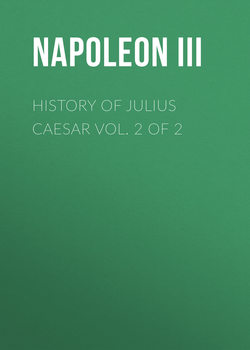Читать книгу History of Julius Caesar Vol. 2 of 2 - Napoleon III - Страница 1
PUBLISHER’S NOTE
ОглавлениеIT is, perhaps, not without interest, in publishing the second volume of the History of Julius Cæsar, written by the Emperor Napoleon III., to call to memory the names of Sovereigns and Princes who have employed themselves upon the same subject.
The King of France, Charles VIII., showed an especial admiration for the Commentaries of Cæsar, and the celebrated monk, Robert Gaguin, presented to him, in 1480, the translation he had made in French of the eight books of the War in Gaul. We are informed of this in the edition of the translation by the learned monk, printed in 1500. This edition, in large 4to, is from the press of Antoine Verard. (See J. Ch. Brunet, Manuel du Libraire et de l’Amateur de Livres, fourth edition, tom. I., p. 518, and the Biographie Universelle, article Charles VIII.)
Charles V., who professed a great admiration for Cæsar, left a copy of the Commentaries filled with marginal notes, written with his own hand. It was at his instigation that the Viceroy of Sicily, Ferdinand Gonzaga, sent a scientific mission into France to study Cæsar’s campaigns on the localities. The forty plans which were made by the members of this commission, and among which that of Alise is found, were published in 1575, in the edition of James Strada.
The Sultan Soliman II., contemporary of Charles V., whom he had taken for his model, sent through all Europe to procure as many copies of Cæsar’s Commentaries as could be found, which he ordered to be collated, and caused a translation to be made into the Turkish language for his own daily reading.
The King of France, Henri IV., translated the two first books of Cæsar’s Commentaries. The manuscript of this translation was deposited in the Bibliothèque du Roi, and M. des Noyers took it thence to deliver it to Louis XIII., who, in his turn, translated the two last books of the Commentaries. These two translations were joined together, and printed at the Louvre in 1630.
Louis XIV. translated the first book of the Commentaries. His translation was printed at Paris in 1651, in folio, with figures. This work has not been reprinted; it is now very rare. The reader may consult on this subject the Méthode d’étudier l’Histoire of the Abbé Lenglet-Dufresnoy, tom. II., p. 481; and J. Ch. Brunet, Manuel du Libraire et de l’Amateur de Livres, fourth edition, tom. I., p. 519.
The great Condé, who had studied with care the campaigns of Cæsar, encouraged the translation of the Commentaries undertaken by Nicolas Perrot d’Ablancourt; it was the translation most esteemed and the most in vogue during the last century.
Christina, Queen of Sweden, had composed Reflections on the Life and Actions of Cæsar, as we are informed by J. Arckenholz in his work entitled Mémoires concernant Christine, Reine de Suède, Amsterdam, 1751-1760, tom. IV., No. 6, p. 4.
Louis Philippe Joseph d’Orléans, surnamed Egalité, was a great reader of the Commentaries. He caused a map of Cæsar’s campaigns in Gaul to be made.
Lastly, the Emperor Napoleon I., at St. Helena, dictated a Précis des Guerres de César to Comte Marchand, who published it in Paris in 1836, in 8vo.
